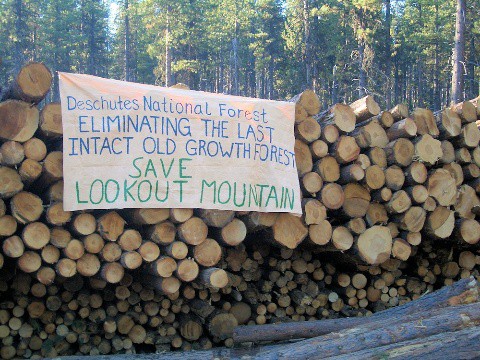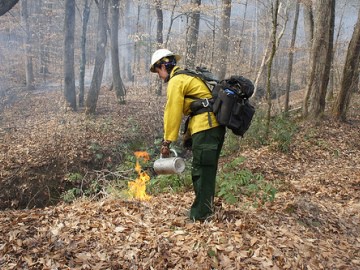
I saw this earlier this week in a Louisville paper. It’s hard for me to criticize newspapers when the whole news business is in such poor shape. I know from experience it’s easier to criticize others, than to produce carefully checked documents on a short time-frame. But it’s still of interest to compare the different kinds of coverage, because this is the journalism situation this country is in, and could have repercussions on public understanding of issues. As usual, my comments are in italics.
New forest-management plan weakens wildlife protection
McClatchy Newspapers
Published Thursday, Feb. 02, 2012
WASHINGTON — Back in the 1980s, when conservation advocates were trying to stop logging in old-growth forests in the Pacific Northwest, they relied on a 1982 regulation that required the National Forest Service to protect wildlife such as the spotted owl throughout its range. They won, and a new Northwest forest plan in 1990 greatly reduced logging in the region’s old-growth forests on federal land.
Now the national planning rule that governs individual national forest plans is about to change, for the first time since the Reagan era. Scientists and environmentalists say many of the changes are improvements, but they object to a key change in the way the plan would protect wildlife.
Technically speaking, the 05 and 08 rules got this far (to publication). How about “some” scientists and “some” environmentalists object. Wouldn’t that be more accurate?
That part of the plan always has been controversial. The timber industry opposes it. Conservationists say it was vital to winning protection for old-growth forests. Now some ecologists and advocates say the Forest Service plan’s change on this point would punch a hole through key protections.
The plan, which covers all uses of forest — including timber harvests, grazing, recreation and wilderness — is expected to become final in early March. Until then, Agriculture Secretary Tom Vilsack could still make changes. But when Vilsack announced the plan last week, he called it “a strong framework to restore and manage our forests and watersheds and help deliver countless benefits to the American people.” The plan is being published Friday in the Federal Register.
It’s interesting that the concept of “environmentalists vs. the timber industry” is in this newspaper, while some of us want to develop a restoration economy that would involve a timber industry. It’s also interesting that of the many groups quoted in many articles, they selected NRDC. Is this because more interesting articles have more controversy? Less interesting than “many groups applaud new rule?” Also if this story was published Thursday in the Bee, and it says the “plan” is in the federal register Friday.. One thing I always think about news articles is “if they don’t check easily checked facts, why should we believe them about complex concepts?
Conservationists say the wildlife provision is a crucial weak point.
“This plan is much less protective than the 1982 Reagan-era one on wildlife protection,” said Niel Lawrence, an attorney with the Natural Resources Defense Council. “This provision is the single strongest protection for the national forests, and the agency is not retaining it.”
Technically, they are quoting one “conservation” group. And a group that really doesn’t specialize in this issue as I pointed out in my previous post here. So far we have the MSNBC and McClatchy stories heavily dependent on NRDC. My usual take is “why didn’t you ask your local environmental groups if you are writing a story?” But McClatchy is national, so I guess has to ask “national” people, who have their own framings of the issue. As the industry consolidates, will we be seeing more of this? Here’s their mission:
The McClatchy Company is the third-largest newspaper company in the United States, a leading newspaper and digital publisher dedicated to the values of quality journalism, free expression and community service. Building on a 154-year legacy of independence, the company’s newspapers and websites are steadfast defenders of First Amendment values and advocates for the communities they serve.
The 1982 rule required the Forest Service to manage fish and wildlife habitat so that healthy populations of animals are “well-distributed” throughout each forest.
The new plan drops that language. Instead, it requires forest managers to maintain habitats. It leaves it up to the official in charge of a region’s forests to decide whether any individual species needs extra protection to ensure that it will continue to exist over the long term with “sufficient distribution.”
The nation’s largest national forest, the Tongass in southeast Alaska, has some land set aside for timber harvests and other areas for recreation and wildlife, as do other national forests. The Tongass’ 2008 plan requires the Forest Service to “maintain contiguous blocks of old-growth forest habitat in a forest-wide system of old-growth reserves” where “viable and well-distributed” populations of animals that depend on this habitat can live.
Under the new national plan, without the “well-distributed” range requirement, managers of the Tongass wouldn’t need wilderness areas spread over the forests’ hundreds of islands, but could limit wildlife protection to smaller areas, Lawrence said.
Brenda Halter-Glenn, who led the team that created the new national plan, said in an interview that the new measure was more realistic about wildlife protection.
“The focus of this rule is on ecological conditions or habitat,” she said. “Those are the things we think through our management actions we can affect. We can create or maintain or restore habitat, but we can’t necessarily ensure that we have viable populations of all species.”
One reason for that, she said, is that some animals, such as migratory birds, also depend on lands that are beyond the Forest Service’s control.
Halter-Glenn said the plan addressed the question of how much discretion to give forest managers by requiring them to show how they used science to inform decisions. “There’s a lot of accountability built in,” she said.
This is where they start to quote “scientists”, which I find interesting from a science policy perspective.
Many scientists, however, are still concerned about the discretionary nature of the plan, said Barry Noon, a professor of wildlife ecology at Colorado State University.
“The requirements aren’t really requirements, because they’re largely discretionary,” Noon said.
In addition, it’s not possible to judge the health of animal populations only by measuring how much vegetation they have, Noon said. The plan also should require monitoring populations of certain animals that are selected to get a sense of overall wildlife health, he said.
This is a planning regulation.. so why would you talk to a wildlife ecologist rather than an expert in planning, say Martin Nie of University of Montana? Scientists are supposed to be experts based on their knowledge of empirical facts. “Shoulds” by definition are normative and are generally not considered to be an appropriate role for scientists.
John McLaughlin, an expert in wildlife ecology and conservation who teaches at the Huxley College of the Environment at Western Washington University in Bellingham, said the plan should protect all native species. The new plan could be more or less protective than the old one, he said. “It depends on who’s making the decisions.”
More “shoulds” from scientists.
In the Northwest, officials attempted during the George W. Bush administration to dismantle the forest plan and open areas to the kind of clear-cutting that was common in the region in the 1970s and earlier. The Obama administration scrapped that effort.
I’m not sure if the is the Northwest Forest Plan, and I’m not sure that the “kind of clearcutting” was the issue, maybe some Northwesterners can chime in here.
But the Bush administration’s attempt to increase logging, McLaughlin argued, is an example of how leaving too much discretion to officials could “make conservation very vulnerable to political whims.”
But one person’s “political whim” is another person’s “will of the people” as manifested through the process of “elections”. But why are we legitimizing the viewpoint of a biologist on a planning and political science question? Here are the backgrounds of Barry Noone and John McLaughlin. I understand Barry because he was on the Committee of Scientists (the 1999 one), but of all the people with experience and study in forest plans, why did they pick McLaughlin to interview? Unless this was a local article for Olympia or Bellingham that then went national.
Conservation groups and the timber industry have fought over the wildlife protection in the forest plan for years.
Rep. Doc Hastings, R-Wash., the chairman of the House Natural Resources Committee, and 58 other members of the Health
really, “Health”?
of Representatives wrote to the Forest Service last May, arguing that the provision in the rule that provides for plant and animal protection in the forests should be eliminated.
They argued that reliance on “best available scientific information” and the expansion of protection to all species — the 1982 rule covered only vertebrates — would cost too much and harm the forests. It also would “reduce the number of jobs in our already distressed rural communities and further limit the amount of the American wood and fiber available to aid our economic recovery,” the wrote.
The timber industry makes the same points.
Ann Forest Burns, a spokeswoman for the American Forest Resource Council, a timber industry group, said the 1982 requirement for healthy animal populations was a mistake in the first place, and that the Forest Service had made it “much worse.”
I don’t know that the FS, or the case law, made it “much worse”.
The timber group also argues that the rule’s wildlife protection terms should mention that the forest plan governs multiple uses of the forest, including logging. “They’ve moved beyond the objectives Congress had for them,” she said.
Conservation groups used the 1982 forest plan to argue for protecting the Northwest’s remaining old-growth forest on federal lands, a habitat that the spotted owl requires.
“If you take that away, there’s no other real legal protection,” said Mike Anderson, an attorney in Seattle for The Wilderness Society. The case for protecting old-growth forests from logging, he said, “has always been based upon it being an important habitat for imperiled species.”
This statement seems a bit dismissive of ESA.
The rule has some strong elements, such as the requirement to maintain and restore the health of ecosystems and watersheds, Anderson said.
“Protection for species as well as the ecosystem are important complementary protections,” he said. “Both need our attention. . . . We’d just like to see the species part strengthened before it becomes final.”
Dominick DellaSala, the president and chief scientist of the Geos Institute in Ashland, Ore., a consulting firm that focuses on addressing climate change, said there was another reason to keep the old forests: They store large amounts of carbon.
Cool-weather rain forests such as the ones in the Northwest and Alaska store more carbon per acre than any other forests do, DellaSala reported in 2010. A Forest Service study last year reported that worldwide, all forests soak up one-third of the carbon dioxide that’s produced by burning fossil fuels, keeping it out of the atmosphere, where it would trap energy and make the planet warmer.
The climate stuff seems like a bit of an unrelated thought, and the whole focus on “old growth” seems a bit Pacific Northwest-centric to me. The spotted owl is so.. one piece of the country and so.. 20th century. Note the quotes are all from PNW folks:
Niel Lawrence Olympia (?)
John McLaughlin Bellingham
Ann Forest Burns Seattle
DellaSala Ashland
Mike Anderson Seattle
Barry Noon Fort Collins Colorado
(which makes me wonder why they didn’t select Norm Johnson in Oregon?)
Which maybe is not so odd in Olympia or Bellingham, but look at the other McClatchy newspapers.
Anchorage Daily News (AK)
Beaufort Gazette (SC)
Belleville News-Democrat (IL)
Bellingham Herald (WA)
(Biloxi) Sun Herald (MS)
Bradenton Herald (FL)
Centre Daily Times (PA)
Charlotte Observer (NC)
Columbus Ledger-Enquirer (GA)
El Nuevo Herald (FL – Spanish)
Fort Worth Star-Telegram (TX)
Fresno Bee (CA)
The (Rock Hill) Herald (SC)
Idaho Statesman (ID)
The Island Packet (SC)
Kansas City Star (MO)
Lexington Herald-Leader (KY)
Merced Sun-Star (CA)
Miami Herald (FL)
Modesto Bee (CA)
(Raleigh) News & Observer (NC)
News Tribune (Tacoma, WA)
The Olympian (WA)
Sacramento Bee (CA)
The State (SC)
he Sun News (SC)
The Telegraph (GA)
The Tribune (CA)
Tri-City Herald (WA)
Wichita Eagle (KS)






